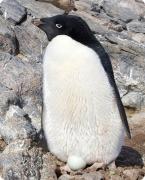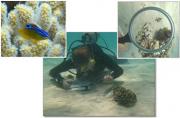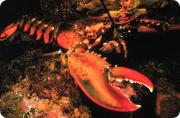Radio Program
Our regular Science and the SeaTM radio program presents marine science topics in an engaging two-minute story format. Our script writers gather ideas for the radio program from the University of Texas Marine Science Institute's researchers and from our very popular college class, Introduction to Oceanography, which we teach to hundreds of non-science majors at The University of Texas at Austin every year. Our radio programs are distributed at to commercial and public radio stations across the country.
Lakes dot the bottom of the Gulf of Mexico: salt lakes − as salty as Great Salt Lake in Utah. They’re infused with a smelly brew of sulfur, hydrogen, methane, and other chemicals. And while that’s not a pleasant environment for most marine life, it does support lots of microscopic life.
The waters around Antarctica are unlike any other waters in the world. They’re cold, deep, and rich with life. And they’re cut off from the other oceans at the surface by a powerful globe-circling current.
In the year 2000, the organization that designates the world’s oceans and seas acknowledged that difference. It named the waters around Antarctica as the fifth ocean − the Southern Ocean.
They may not be able to fly, but like some of their airborne cousins, Adelie penguins follow the Sun. As the year goes by, they can migrate thousands of miles. In part, that’s to follow the Sun, finding areas with at least a few hours of sunlight per day. That suggests that the penguins must need at least some sunlight to survive.
For a young fish, moving too slow can get you snapped up by a bigger fish. But so can moving too fast, or even being too timid.
When small fish that live on coral reefs hatch, they stay near the surface, generally following the currents. When they get older, though, they settle on a nearby reef. But most of these new arrivals get eaten within a couple of days.
A recent study found a few common traits among the fish that are the first to go.
It sounds like something “Q” would have whipped up in a James Bond movie: a submarine bristling with lights, cameras, and a robotic arm for finding and grabbing things on the ocean floor, and even wheels for “driving” along the bottom.
But Naval Research Vessel 1 -- NR-1 for short -- was a real submarine designed for real Cold War missions. And when it wasn’t pursuing super-secret military operations, it helped marine scientists probe the ocean depths.
Before the days of the Roman Empire, monk seals were just about as plentiful on Mediterranean beaches as tourists are today. Because of the seals’ love of sun and sea, the Greeks placed them under the protection of the gods Apollo and Poseidon.
Today, the Mediterranean monk seal could use a little of that divine protection. It’s one of the most endangered mammals in the world.
During one of his voyages to the New World, Christopher Columbus spotted a group of “sea wolves” lounging on the beaches of the present-day Dominican Republic. He ordered his men to kill eight of them for food. After that, it was all downhill for the Caribbean monk seal. The last one was seen in 1952, and a species that once ranged from the Florida Keys to the shores of South America has been declared extinct.
You can only push a person so far. In the early Massachusetts colony, for example, indentured servants were so incensed at the diet provided by their masters that they demanded a change: they couldn’t be required to eat lobster more than three times a week.
Such is the nature of changing times and changing tastes. In the 17th and 18th centuries, lobster was sneered at -- it was used for fertilizer or bait, or fed to slaves, criminals, and servants.
To fully understand how a living thing works, you have to study it under conditions like those in which it lives. And that applies down to the level of individual cells.
That’s one of the lessons learned and taught by Ernest Everett Just, one of the first African-American biologists.
Just was born in South Carolina in 1883. After his father died a few years later, his family moved to an island. There, Just developed a love of the nature around him -- a love that he maintained throughout his career.
An artificial reef sits on the floor of the Atlantic Ocean southeast of New York City -- a twisted Cold War artifact of steel and concrete. A few anglers and divers occasionally visit, but otherwise it sits quietly -- a memorial to the men who perished there, and to failed technology.
The structure was one of five “Texas Towers” -- named for their resemblance to offshore oil platforms -- that were planned to warn of Russian bomber attacks on the Northeast. Three were built, in the 1950s.







